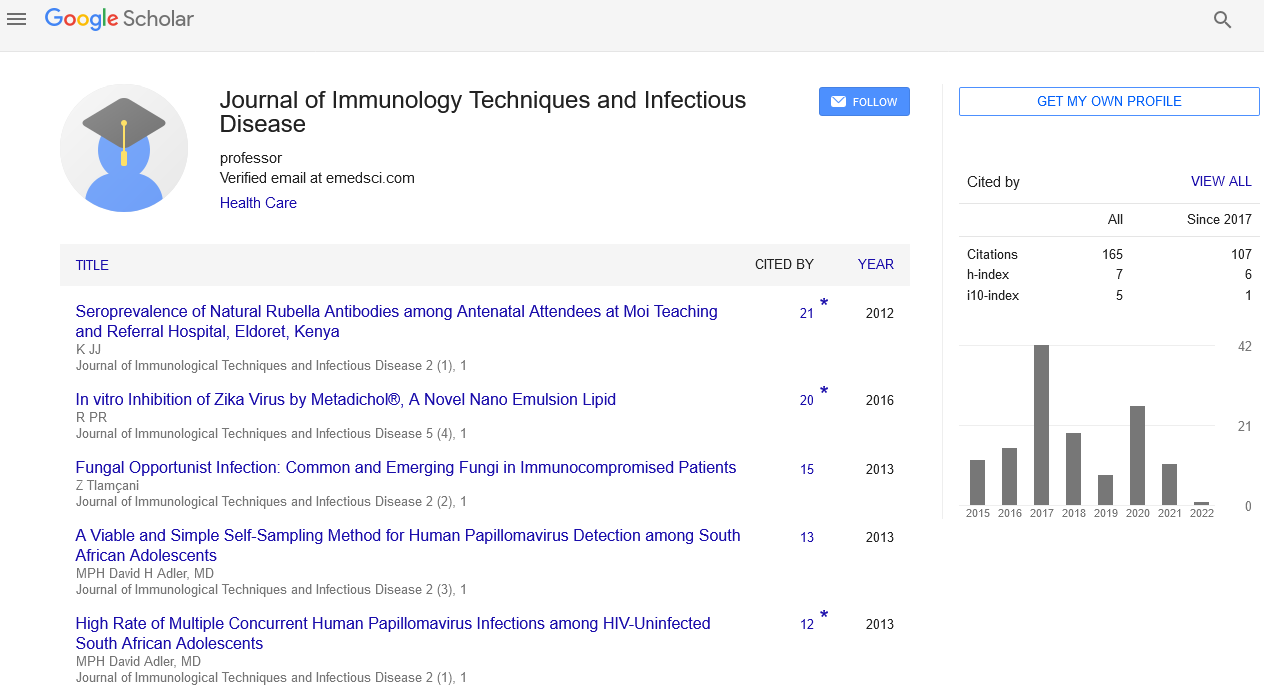Commentary, J Immunol Tech Infect Dis Vol: 13 Issue: 2
Nature of Airborne Diseases and their Common Classification
Chun Yunge*
1Department of Immunology, The Chinese University of Hong Kong, Hong Kong, China
*Corresponding Author: Chun Yunge,
Department of Immunology, The Chinese
University of Hong Kong, Hong Kong, China
E-mail: yung.ch@gmail.com
Received date: 28 May, 2024, Manuscript No. JIDIT-24-146456;
Editor assigned date: 31 May, 2024, PreQC No. JIDIT-24-146456 (PQ);
Reviewed date: 14 June, 2024, QC No. JIDIT-24-146456;
Revised date: 21 June, 2024, Manuscript No. JIDIT-24-146456 (R);
Published date: 28 June, 2024, DOI: 10.4172/2329-9541.1000385.
Citation: Yunge C (2024) Nature of Airborne Diseases and their Common Classification. J Immunol Tech Infect Dis 13:2.
Description
Airborne diseases are illnesses that spread through the air and tiny pathogens such as viruses, bacteria, or fungi. These microorganisms can be released into the air when an infected person sneezes, coughs, talks, or even breathes. Once airborne, these pathogens can be inhaled by others, leading to the spread of disease.
Nature of airborne diseases
Airborne diseases are primarily caused by microorganisms such as viruses, bacteria, and fungi that can travel through the air. These pathogens are typically enclosed in droplets of moisture, which are expelled from the respiratory tract of an infected person. The droplets can remain suspended in the air for varying periods, depending on their size and the surrounding environmental conditions. Smaller droplets, known as aerosols, can linger in the air for extended periods and it can be inhaled by others, leading to infection. Airborne diseases can vary from common respiratory infections to life-threatening disorders. The impact of these diseases can be exacerbated by factors such as population density, the presence of vulnerable individuals (such as those with weakened immune systems), and environmental conditions that facilitate the spread of pathogens.
Common airborne diseases
Several illnesses have been demonstrated to spread through the air. Some of the most common and impactful airborne illnesses. Influenza, commonly known as the flu, it is a viral infection that affects the respiratory system. It spreads through respiratory droplets and can cause symptoms ranging from mild to severe, including fever, cough, sore throat, and body aches. Influenza can lead to serious complications, particularly in young children, the elderly, and individuals with underlying health conditions. Tuberculosis is a bacterial conditions caused by the mycobacterium tuberculosis. It typically affects the lungs, although it can extend to other areas of the body. TB is spread through aerosol transmission, and individuals with active TB can release bacteria into the air when they cough or sneeze. Tuberculosis is a major global health disease, particularly in low and middle income countries.
COVID-19 is caused by the SARS-CoV-2 virus; COVID-19 emerged as a global pandemic in 2019. The virus primarily spreads through respiratory droplets and aerosols, and it can cause a wide range of symptoms, from mild respiratory issues to severe illness and death. The pandemic highlighted the challenges of controlling airborne diseases in a globalized world. Measles is a highly pathogenic bacterial virus transmitted by respiratory droplets. Symptoms include a fever, cough, runny nose, and a distinctive red rash. Measles can lead to serious complications, particularly in young children, and it remains a significant cause of death in some parts of the world, despite the availability of a highly effective vaccine.
Chickenpox caused by the varicella-zoster virus, chickenpox is a common childhood infection that spreads through the air and direct contact with fluid from chickenpox blisters. The disease is characterized by an itchy rash and symptoms similar to the flu. While chickenpox is usually mild, it can cause severe complications in some individuals. Pertussis is an infection of bacteria caused by Bordetella pertussis. It spreads through respiratory droplets and it is known for causing severe coughing fits, which can be particularly dangerous in infants and young children. Vaccination has significantly decreased the prevalence of pertussis, additionally epidemics continue to develop.
 Spanish
Spanish  Chinese
Chinese  Russian
Russian  German
German  French
French  Japanese
Japanese  Portuguese
Portuguese  Hindi
Hindi 
